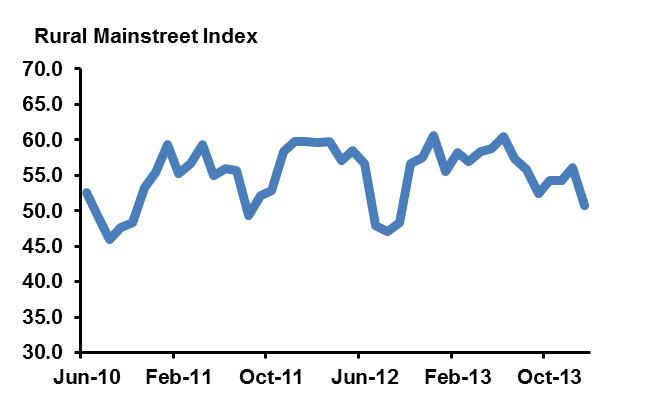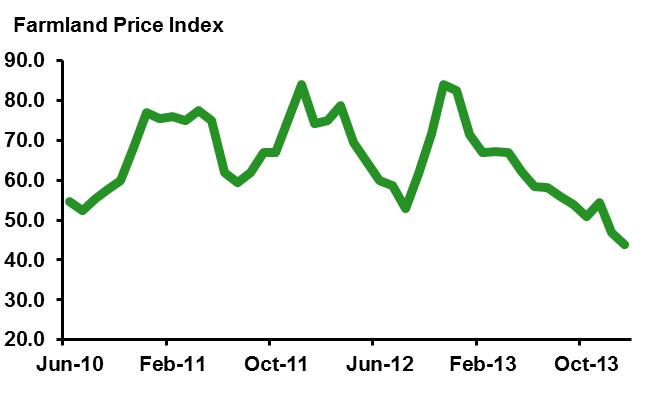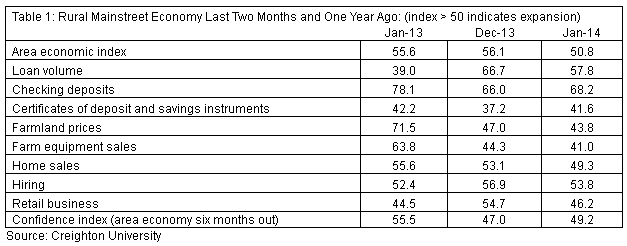The rural economy expanded for the 16th month in a row according to Midwestern bankers, despite lower commodity prices. Bankers are concerned though about the rural economy over the next six months and the uncertainty of the Farm Bill. Farmland values and farm equipment sales continue to trend lower from last month, which can be attributed to the uncertainty of the commodities market entering 2014.
The Rural Mainstreet Index, ranging between 0 and 100 with 50.0 representing growth neutral, decreased to 50.8 from a 56.1 in December, remaining above growth neutral for the 16th month in a row. Ernie Goss PhD., economist at Creighton University, suggests the reason for slower rate of growth is due to the decrease in corn, soybean and wheat prices. Goss stated, “Over the past year, corn, soybean and wheat prices have declined by 41 percent, 10 percent and 16 percent, respectively. Weaker farm prices are clearly negatively influencing the rural economy.”
The farmland price index decreased to 43.8 from 47.0. Goss believes the decrease in commodity prices have influenced farmland values. “This is the second straight month that the farmland and ranchland-price index has moved below growth neutral. As agriculture commodity prices have moved lower, so have farmland prices. On the other side of the economic coin, ranchers and livestock producers are experiencing record prices and a very healthy economic outlook,” commented Goss.
Farm equipment sales sank to 41.0 from 44.3. Goss again attributes falling commodity prices to the decline in equipment sales saying, “Over the past year, commodity prices for all farm products have declined by roughly 8 percent. This has significantly reduced farmers’ willingness to undertake major agriculture equipment purchases.”
Bankers were asked this month about ending the Federal Reserve’s bond buying program (QE3) and the impact of the EPA’s recommended cuts to required ethanol blending if implemented. Nearly half of the bankers want the Fed to continue the bond buying program dependent on data, while 27.2% wanted QE3 to be completed by the end of 2014. The majority of bankers believed the EPA’s recommended cuts to the ethanol mandate would have a modest negative impact on the rural economy.
This survey represents an early snapshot of the economy of rural, agricultural and energy-dependent portions of the nation. The RMI is a unique index covering 10 regional states, focusing on approximately 200 rural communities with an average population of 1,300. It gives the most current real-time analysis of the rural economy.
- English (UK)
- English (India)
- English (Canada)
- English (Australia)
- English (South Africa)
- English (Philippines)
- English (Nigeria)
- Deutsch
- Español (España)
- Español (México)
- Français
- Italiano
- Nederlands
- Português (Portugal)
- Polski
- Português (Brasil)
- Русский
- Türkçe
- العربية
- Ελληνικά
- Svenska
- Suomi
- עברית
- 日本語
- 한국어
- 简体中文
- 繁體中文
- Bahasa Indonesia
- Bahasa Melayu
- ไทย
- Tiếng Việt
- हिंदी
Rural Economic Growth Slows In January
Published 01/20/2014, 06:13 AM
Updated 07/09/2023, 06:31 AM
Rural Economic Growth Slows In January
Latest comments
Loading next article…
Install Our App
Risk Disclosure: Trading in financial instruments and/or cryptocurrencies involves high risks including the risk of losing some, or all, of your investment amount, and may not be suitable for all investors. Prices of cryptocurrencies are extremely volatile and may be affected by external factors such as financial, regulatory or political events. Trading on margin increases the financial risks.
Before deciding to trade in financial instrument or cryptocurrencies you should be fully informed of the risks and costs associated with trading the financial markets, carefully consider your investment objectives, level of experience, and risk appetite, and seek professional advice where needed.
Fusion Media would like to remind you that the data contained in this website is not necessarily real-time nor accurate. The data and prices on the website are not necessarily provided by any market or exchange, but may be provided by market makers, and so prices may not be accurate and may differ from the actual price at any given market, meaning prices are indicative and not appropriate for trading purposes. Fusion Media and any provider of the data contained in this website will not accept liability for any loss or damage as a result of your trading, or your reliance on the information contained within this website.
It is prohibited to use, store, reproduce, display, modify, transmit or distribute the data contained in this website without the explicit prior written permission of Fusion Media and/or the data provider. All intellectual property rights are reserved by the providers and/or the exchange providing the data contained in this website.
Fusion Media may be compensated by the advertisers that appear on the website, based on your interaction with the advertisements or advertisers.
Before deciding to trade in financial instrument or cryptocurrencies you should be fully informed of the risks and costs associated with trading the financial markets, carefully consider your investment objectives, level of experience, and risk appetite, and seek professional advice where needed.
Fusion Media would like to remind you that the data contained in this website is not necessarily real-time nor accurate. The data and prices on the website are not necessarily provided by any market or exchange, but may be provided by market makers, and so prices may not be accurate and may differ from the actual price at any given market, meaning prices are indicative and not appropriate for trading purposes. Fusion Media and any provider of the data contained in this website will not accept liability for any loss or damage as a result of your trading, or your reliance on the information contained within this website.
It is prohibited to use, store, reproduce, display, modify, transmit or distribute the data contained in this website without the explicit prior written permission of Fusion Media and/or the data provider. All intellectual property rights are reserved by the providers and/or the exchange providing the data contained in this website.
Fusion Media may be compensated by the advertisers that appear on the website, based on your interaction with the advertisements or advertisers.
© 2007-2025 - Fusion Media Limited. All Rights Reserved.
